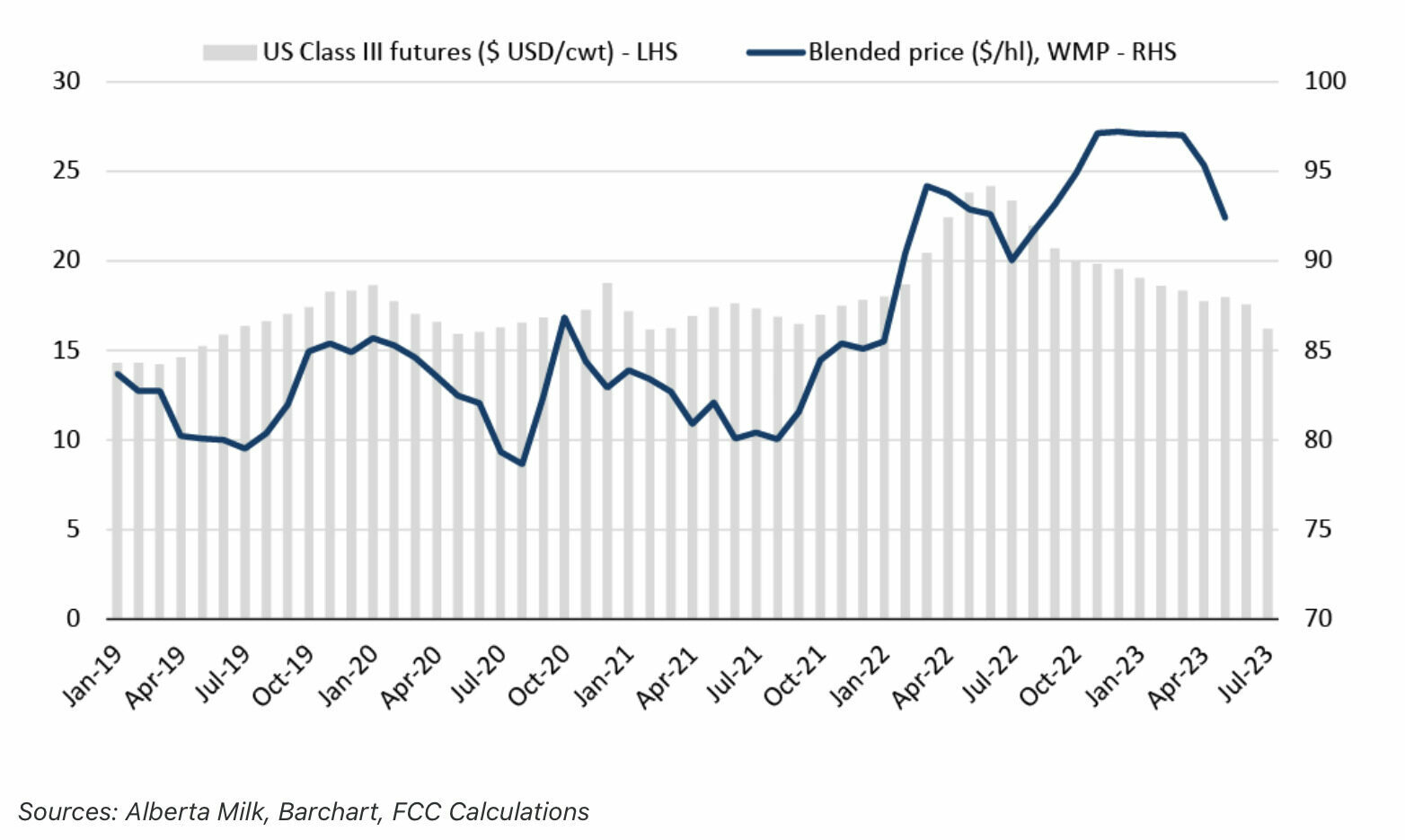



Canadian dairy revenues forecast downward - FCC
American milk production at record highMarket dynamics in the US dairy industry are beginning to pressure the income of Canadian dairy producers, according to a recent market update from Farm Credit Canada.
American milk production is at a record high, and processors cannot keep up. This is putting downward pressure on US milk prices and consequently, Canadian milk prices. Approximately 12% of Canadian butterfat production (by weight) goes into Class 5 milk, and Class 5 milk prices are exposed to changes in US prices.
Canadian producers ‘rode the wave’ of strong US milk prices in 2022 but are now beginning to see downward pressure on domestic prices as the US situation worsens, said senior analyst Graeme Crosbie. In May 2023, the average blended price in the Western Milk Pool (WMP) was $92/hl, unchanged from May 2022 despite two Canadian Dairy Commission increases in the butterfat support price. The biggest reason: US Class III milk prices declined 30% during that time.
Class III milk futures are flat (approximately $16/cwt) for the remainder of 2023, nowhere near the highs of $24/cwt seen in June 2022.
As a result of these developments, FCC's forecasts for dairy revenues have been revised downward.

Trends to watch in 2023
In January, FCC identified the following items as influential factors to monitor in 2023.
1. Elevated input costs
Feed remains an issue for dairy producers across the country. Increasing drought and pest concerns on the Prairies – particularly in Alberta – are creating uncertainty about silage quality and quantity this year. First cut of hay was better in the central and eastern Prairies but the limited amount of moisture since the spring is leaving second cut uncertain. In the East, price remains an issue. Corn conditions started the growing season poorly in the US Midwest but have improved recently, leaving the direction of feed costs a risk for the year ahead.
2. Butter stock levels
Total butterfat production has been strong so far this year with production in each month of 2023 higher than in any comparable month from the last five years. Increased butterfat production to date has resulted from increased efficiency rather than an increase in quota or incentive days. However, in May, the P5 announced an additional two incentive days for the summer. This brings the total number of incentive days for the P5 to nine incentive days for the year. Only two incentive days have been announced for the WMP (September and October), but these are the first incentive days since 2019. All incentive days for 2023 occur between May and November, a period of lower production and higher demand, resulting in historically low butter stock levels.
3. Imports of dairy products
A new dairy year starts in August and, with it, a new window for dairy imports under the Canada-United States-Mexico Agreement (CUSMA) that operate on a dairy year basis. As per the agreed-upon schedule, the tariff-rate quotas will increase this upcoming dairy year. Canada could see a surge of butter imports this fall if these tariff-rate quotas are front-loaded (that is, filled at the beginning of the dairy year, which is the second half of the calendar year), which is certainly possible given lower butter stocks and stable demand. Milk, cream and butter are the three main dairy products with tariff-rate quotas on a dairy-year basis. The US has been taking advantage of incrementally increased access for butter and cream, with fill rates above 80% in each of the last three years.
4. Retail price inflation
The overall inflation rate fell to 2.8% in June, yet food prices continued to increase at a stubbornly high rate (9.1% for food purchased from grocery stores). This is true across nearly all food categories, including dairy products.
The Canadian Dairy Commission reports that trends in consumption of dairy products over the last 12 months have been mixed across products: increases for some (ice cream, cheese) and decreases for others (milk, butter).
In conclusion, the US milk glut is keeping a lid on Canadian blended prices. Revenue on a per unit basis ($/hl) is down, but quantities are up – and should stay elevated, given upcoming incentive days – as the race to replenish butter stocks continues. This bodes well for moderate total revenue growth for 2023. Feed availability in the west and feed costs in the east will continue to be an issue for profitability over the remainder of 2023.



